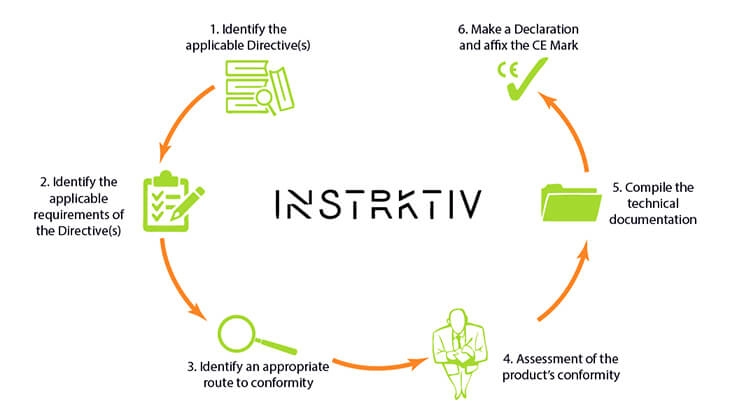The CE Marking Process (6 Simple Steps)
20/02/2023 Law and Legislation
CE marking is a certification mark that indicates conformity with health, safety, and environmental protection standards for products sold within the European Economic Area.
When a product bears the CE mark, it means that the manufacturer has declared conformity of the product to all CE requirements. In order to obtain CE marking, you need to follow the CE marking process.
So what does the CE marking process look like?
The CE marking process consists of 6 simple steps. In this overview I set out the steps that all manufacturers, importers and distributors should do to obtain CE marking.
Read on and learn how you can obtain CE marking for your product by following the six steps of the CE marking process.
Don’t have time to read the whole guide right now?
DOWNLOAD THE CE MARKING PROCESS GUIDE
Step 1 of the CE marking process: identify the applicable legislation and harmonised standards
How do you know if your product requires a CE mark? The first step is to see if your product is covered under one or more of the CE directives.
I have created a guide to CE marking that contains an overview of all CE directives and regulations.
To determine if a certain directive applies to your product, consult the instructions from this post.
Each directive gives requirements on what the EU legally requires for your product to comply with. These requirements are formally referred to as the essential safety and health requirements (ESHR) and are very general in nature.
The directives do not detail how to design a product in such a way that it meets the essential requirements, or what the user instructions should look like.
Harmonised standards describe in much more detail how you can technically meet the requirements of the directives. Though harmonised standards are not mandatory, by applying them you create the highest level of presumption of conformity with essential requirements of the directives.
Although the standards change every now and then, as does the website of the European Commission, here is a web address where you may find some standards by clicking on one of the product groups:
Otherwise, search for standards on the websites of one of the standardisation institutes:

Step 2 of the CE marking process: verify product specific requirements
Not every requirement in a directive or harmonised standard applies to every product.
For example, if your product is machinery, but not handheld machinery, the requirements for handheld machinery will not apply to your product. That’s why you should check the directives and harmonised standards for those requirements that apply to your product.
In many cases, manufacturers may rely on standards other than harmonised standards in order to demonstrate compliance with the essential requirements in the directives. These can be non-harmonised standards or industry standards.
To verify the requirements that apply to your product, I suggest you use one of the following options.
The first option is to highlight the requirements in the directive/standards that are relevant for your product.
The other option is to create a spreadsheet in which you copy/paste all requirements. You then add one column titled "Compliance status" behind the requirements where you can later indicate if the product complies with the standard (YES), does not comply (NO) or when the requirement does not apply to your product (N/A).
Step 3 of the CE marking process: identify whether an independent conformity assessment (by a notified body) is necessary
Some directives require products to be tested and certified by a third-party organisation, or a so-called notified body, in order to ensure their conformity with the relevant essential requirements.
These directives (and regulations) include the medical device regulation, the ATEX directive, the pressure equipment directive, the gas appliance directive, and the simple pressure vessels directive.
If applicable directives do not require the use of a notified body, manufacturers may perform the conformity assessment themselves. In some cases, such as to comply with the requirements of the machinery directive and toy directive, the only time a notified body is not required is if the manufacturer uses a harmonised standard.
Consult the relevant directives to find out if you can conduct the conformity assessment yourself, or if you need to have it done by a notified body.
DO YOU WANT TO KNOW WHICH DIRECTIVES APPLY TO YOUR PRODUCT?
Follow these steps and conduct the first step of the CE marking process yourself.
Step 4 of the CE marking process: test the product and check its conformity
How do you know that your product complies with the essential requirements in the applicable directives?
You will have to test and document that your product actually conforms. Each directive outlines which conformity assessment procedures – also referred to as modules – a manufacturer can undertake.
There are 8 conformity assessment modules. The applicable directives outline which module(s) apply to a particular product category.
- Module A: Internal production control
- Module B: EC type examination
- Module C: Conformity to type
- Module D: Production quality assurance
- Module E: Product quality assurance
- Module F: Product verification
- Module G: Unit verification
- Module H: Full quality assurance (EN ISO 9001)
Step 5 of the CE marking process: draw up and keep available the required technical file
All CE marking directives impose an obligation for the manufacturer to create and make available a technical file (or technical documentation) containing information which demonstrates that the product conforms to the requirements of the directive.
A technical file relevant to a CE-marked product must be kept for at least 10 years from the last date the product was manufactured, unless the directive provides for a later date.
The technical file must be provided to enforcement authorities on demand, often within short timelines. The technical file needs to be kept up to date, especially when the product is modified or is subject to updated conformity assessment procedures.
Each directive has different requirements on what should be in the technical file. As an example, the technical file for low voltage products should contain:
- A general description of the electrical equipment.
- Conceptual design and manufacturing drawings and diagrams of components, sub-assemblies, circuits, etc.
- Descriptions and explanations necessary for the understanding of those drawings and diagrams and the operation of the electrical equipment.
- A list of the harmonised standards applied in full or in part, and in the case of partly applied standards, the technical documentation shall specify the parts which have been applied.
- Results of design calculations made, examinations carried out, etc.
- Test reports.
Step 6 of the CE marking process: affix the CE marking and draw up the EU declaration of conformity
Once the technical file has been completed, as a manufacturer you can declare compliance with the directives by drafting and signing the declaration of conformity (see here for DoC templates).
The declaration of conformity is an acknowledgement by the manufacturer that they are responsible for the compliance of their products with the applicable directives.
The declaration should be available to authorities at the EU point of entry. The declaration of conformity generally includes the following:
- Who you are.
- What product it refers to.
- What directives are involved.
- Which standards have been used.
- Where test results can be found.
- Who is responsible in your company.
 |
Ferry Vermeulen is a technical communication and compliance expert. He also is a parttime trainer at the Dutch standardisation institute (NEN). Listen to the INSTRKTIV podcast on Spotify or read one of his latest blog articles. Linkedin I Spotify I YouTube I Facebook I Twitter |
DO YOU WANT TO KNOW WHICH DIRECTIVES APPLY TO YOUR PRODUCT?
Follow these steps and conduct the first step of the CE marking process yourself.
